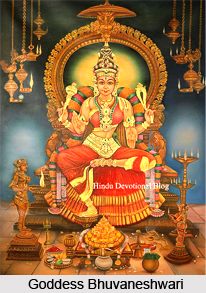 Goddess Bhuvaneshwari is considered as the fourth of the Ten Mahavidya goddesses in Hinduism. Goddess Bhuvaneshwari is said to be an incarnation of Goddess Shakti. As a queen of the universe, she is interested in the welfare of her subjects and resides in the heart chakra. According to a legend, once Lord Brahma, Lord Vishnu and Lord Shiva quarrelled over who was supreme. When the quarrel became too serious, the Divine Mother took them to her abode, where they saw themselves as three women attendants, taking care of creation, preservation and destruction.
Goddess Bhuvaneshwari is considered as the fourth of the Ten Mahavidya goddesses in Hinduism. Goddess Bhuvaneshwari is said to be an incarnation of Goddess Shakti. As a queen of the universe, she is interested in the welfare of her subjects and resides in the heart chakra. According to a legend, once Lord Brahma, Lord Vishnu and Lord Shiva quarrelled over who was supreme. When the quarrel became too serious, the Divine Mother took them to her abode, where they saw themselves as three women attendants, taking care of creation, preservation and destruction.
Origin of Goddess Bhuvaneshwari
Bhuvaneshwari is thus the Queen (Ishvari) of the phenomenal world (Bhuvan). Thus Bhuvaneshwari means the queen or ruler of the universe, the realm of being. It is the prime force Parashakti, which manifests herself as the phenomenal world. The whole universe is her body and all beings are ornaments on her infinite being.
There are numerous legends and folk stories associated with her origin. She is mainly associated with Lord Shiva and some consider her as an incarnation of Goddess Parvati. She is also known as "Om Shakti" or "Adi Shakti" i.e. one of the earliest forms of Shakti. She is known as "Aditi", the infinite or the indivisible Mother in the Vedas. The goddess carries all the worlds as a flowering of her own Self-nature. She is thus related to "Sundari" and to "Rajarajeshwari", the supreme Lady of the Universe. In all forms she plays the role of creator and protector.
Iconography of Goddess Bhuvaneshwari
The complexion of Goddess Bhuvaneshwari is vermillion in colour. She has three eyes and is adorned with crown studded with jewels. She wears a smiling face and has the disk of the moon on her brow. In her two hands she holds a red lotus and a bowl filled with jewels. The goddess is extremely compassionate and loving. The goddess places her right foot on a jewelled jar. The goddess is seated on a red lotus and is adorned with pearls of many colours.
Worshipping of Goddess Bhuvaneshwari
Worshipping the Goddess Bhuvaneshwari promotes cosmic vision and liberates from the narrowness of opinion and belief. Goddess Bhuvaneshwari is the power of love, which creates space and gives freedom.




















